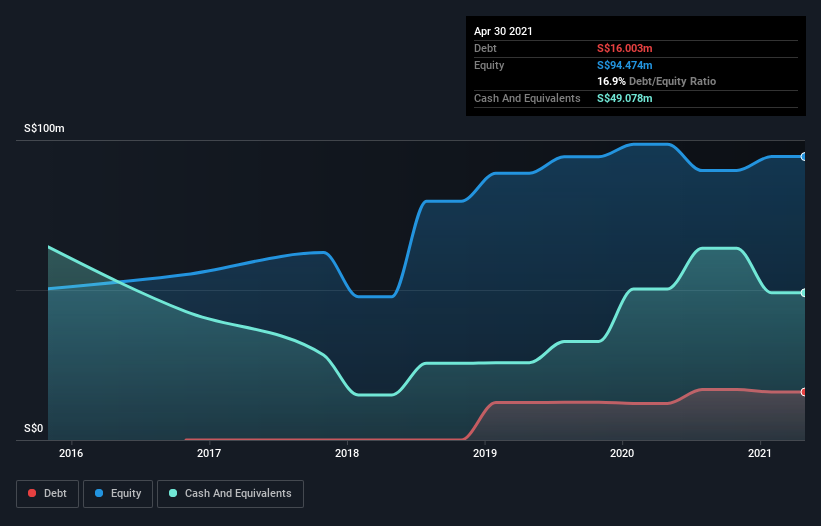Warren Buffett famously said, 'Volatility is far from synonymous with risk.' It's only natural to consider a company's balance sheet when you examine how risky it is, since debt is often involved when a business collapses. As with many other companies HPC Holdings Limited (HKG:1742) makes use of debt. But the more important question is: how much risk is that debt creating?
Why Does Debt Bring Risk?
Debt and other liabilities become risky for a business when it cannot easily fulfill those obligations, either with free cash flow or by raising capital at an attractive price. In the worst case scenario, a company can go bankrupt if it cannot pay its creditors. However, a more usual (but still expensive) situation is where a company must dilute shareholders at a cheap share price simply to get debt under control. By replacing dilution, though, debt can be an extremely good tool for businesses that need capital to invest in growth at high rates of return. The first step when considering a company's debt levels is to consider its cash and debt together.
Check out our latest analysis for HPC Holdings
What Is HPC Holdings's Debt?
You can click the graphic below for the historical numbers, but it shows that as of April 2021 HPC Holdings had S$16.0m of debt, an increase on S$12.2m, over one year. But it also has S$49.1m in cash to offset that, meaning it has S$33.1m net cash.

How Healthy Is HPC Holdings' Balance Sheet?
Zooming in on the latest balance sheet data, we can see that HPC Holdings had liabilities of S$53.7m due within 12 months and liabilities of S$17.7m due beyond that. Offsetting these obligations, it had cash of S$49.1m as well as receivables valued at S$86.0m due within 12 months. So it can boast S$63.7m more liquid assets than total liabilities.
This excess liquidity is a great indication that HPC Holdings' balance sheet is almost as strong as Fort Knox. On this view, lenders should feel as safe as the beloved of a black-belt karate master. Simply put, the fact that HPC Holdings has more cash than debt is arguably a good indication that it can manage its debt safely. There's no doubt that we learn most about debt from the balance sheet. But you can't view debt in total isolation; since HPC Holdings will need earnings to service that debt. So if you're keen to discover more about its earnings, it might be worth checking out this graph of its long term earnings trend.
In the last year HPC Holdings had a loss before interest and tax, and actually shrunk its revenue by 11%, to S$173m. That's not what we would hope to see.
So How Risky Is HPC Holdings?
By their very nature companies that are losing money are more risky than those with a long history of profitability. And in the last year HPC Holdings had an earnings before interest and tax (EBIT) loss, truth be told. And over the same period it saw negative free cash outflow of S$4.9m and booked a S$4.0m accounting loss. With only S$33.1m on the balance sheet, it would appear that its going to need to raise capital again soon. Overall, its balance sheet doesn't seem overly risky, at the moment, but we're always cautious until we see the positive free cash flow. When analysing debt levels, the balance sheet is the obvious place to start. But ultimately, every company can contain risks that exist outside of the balance sheet. Case in point: We've spotted 2 warning signs for HPC Holdings you should be aware of, and 1 of them doesn't sit too well with us.
When all is said and done, sometimes its easier to focus on companies that don't even need debt. Readers can access a list of growth stocks with zero net debt 100% free, right now.
Valuation is complex, but we're here to simplify it.
Discover if HPC Holdings might be undervalued or overvalued with our detailed analysis, featuring fair value estimates, potential risks, dividends, insider trades, and its financial condition.
Access Free AnalysisThis article by Simply Wall St is general in nature. We provide commentary based on historical data and analyst forecasts only using an unbiased methodology and our articles are not intended to be financial advice. It does not constitute a recommendation to buy or sell any stock, and does not take account of your objectives, or your financial situation. We aim to bring you long-term focused analysis driven by fundamental data. Note that our analysis may not factor in the latest price-sensitive company announcements or qualitative material. Simply Wall St has no position in any stocks mentioned.
Have feedback on this article? Concerned about the content? Get in touch with us directly. Alternatively, email editorial-team (at) simplywallst.com.
About SEHK:1742
HPC Holdings
An investment holding company, engages in civil engineering, general building construction, and upgrading works in Singapore.
Solid track record with excellent balance sheet.
Market Insights
Community Narratives



